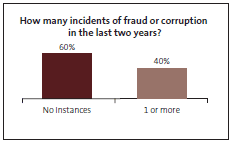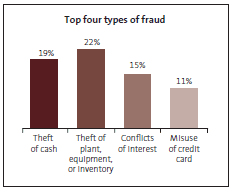Part 3: Incidents of fraud in State-owned enterprises
 Despite our generally "clean" image, fraud is a fact of business life in New Zealand: 40% of respondents were aware of at least one incident of fraud or corruption in their SOE within the last two years.
Despite our generally "clean" image, fraud is a fact of business life in New Zealand: 40% of respondents were aware of at least one incident of fraud or corruption in their SOE within the last two years.
Those who knew of an incident in the last two years were asked for details of the most recent incident.
The value of the most recent fraud noted by respondents in SOEs was mostly low, with 42% for amounts of less than $10,000. Respondents put the monetary loss for 16% of fraud incidents between $10,000 and $100,000, and 11% at more than $100,000. About 32% of the respondents who answered this question did not know how much money was lost.
It is not always possible to accurately establish how much money has been lost in a fraud because sometimes the records and the investigation are incomplete. The percentage of frauds of more than $100,000 (11%) was higher for SOEs than it was for the wider central government sector (8%) and for the public sector overall (5%).
Most of the fraud incidents in SOEs (68%) were committed by one internal person acting alone, typically at an operational staff level.
 The most frequent types of fraud within SOEs were:
The most frequent types of fraud within SOEs were:
- theft of cash (19%);
- conflicts of interest1 (15%);
- theft of property, plant, equipment, or inventory (22% combined); and
- misuse of a credit card (11%).
The most common reason why fraud occurred was because internal control policies and procedures were not followed (44%) and that the perpetrator did not think they would get caught (28%).
Internal control systems were SOEs' most successful mechanism for detecting fraud, with 27% of frauds detected in this way. Internal tip-offs (other than through a formal whistle-blowing system) led to 15% of the frauds detected, and fraud detection systems detected a further 19%.
Respondents said that none of the fraud incidents were detected by the external auditor. This is not surprising, because detecting fraud is neither the purpose nor the focus of an external audit.
Questions 32 to 40 in Appendix 1 set out the survey response data about incidents of fraud.
1: Conflicts of interest include paying or receiving backhanders and receiving undeclared gifts or services to influence decision-making or in return for preferential treatment.
page top